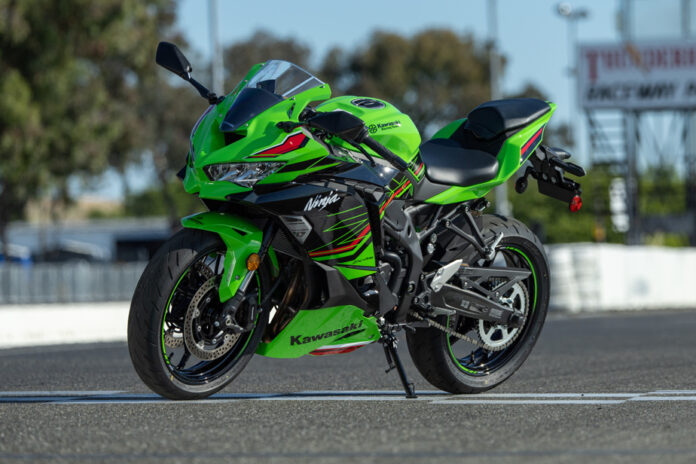200 horsepower – and more… – have become the norm in the most powerful sports cars, making them both extraordinarily exhilarating and exhausting to fully exploit on the track. With three to four times less power, the new Kawasaki Ninja ZX-4R proves that going in the opposite direction is a whole new kind of fun.
Between the end of the 1980s and the beginning of the 1990s, due to severe regulations limiting access to large engines in Japan, Japanese manufacturers started producing 250 cc and 400 cc sports cars producing a surprising power thanks to in-line four-cylinders running at stratospheric speeds. The youngest may have never heard of it, but rare are the slightly older motorcyclists, especially sports enthusiasts, who have not dreamed of one day owning one of these legendary machines reserved almost exclusively in the Japanese market.
No wonder, then, that the all-new 2023 Kawasaki Ninja ZX-4R and especially its better-equipped version, the RR, are attracting so much interest from experienced riders who normally would never have given importance to a model of 400 cc starter. Indeed, while a Ninja400, for example, is only an (excellent) small motorcycle intended for novices, the 4R/RR is intended to be nothing more or less than a two-thirds version of a pure 600 cc sports car. . It is about a frame capable of rolling very quickly on the track and which stands out with its very high revolutionizing in-line four-cylinder, in short, a replica of the mythical 400 of the Japanese market.
The good first: originally reserved for Europe, the ZX-4R/RR is finally also offered in Canada. The less good news is that the only models sold in North America in 2023 are essentially European motorcycles that do not meet a California noise standard. Kawasaki’s solution was to electronically limit the novelty until it met said standard by capping power at 11,500 rpm. The result is power that climbs to around 55 horsepower, then stays steady until the top revs of 16,000 rpm – up from the roughly 75 horsepower produced by the Ninja 4R/RR on the Old Continent.
Even serious sports enthusiasts struggle to visually distinguish the ZX-4R/RR from its 600 cc and 1000 cc siblings. Installed at his controls, it looks like a 600 a little more slender and light. From a mechanical point of view, there are a few components slightly behind, such as a steel frame rather than aluminum, less massive suspensions and offering fewer adjustments as well as a narrower rear tire, but for the rest , it is indeed a question of an authentic modern sports car, and this, especially in the case of the RR version offering a more dynamic paint, better suspensions and an assisted gear change system.
In a road environment, the ZX-4RR takes the form of an excellent little initiation sports car. Every nuance of typical motorcycle handling is there, from the comfort-reducing rockered stance, to the pronounced feeling of cornering precision, to the utterly delicious howl of the tiny four-cylinder at full throttle. One exception, however, is power, since in this regard, we are definitely dealing with novice-caliber performance, especially in our market where not all the horses are present. The accelerations are nevertheless more than sufficient to leave the automobile traffic behind and circulate without the slightest problem at a fast pace on the highway.
To own a ZX-4R – and especially the RR version – without taking it to the track is pure waste, even sacrilege. The modest quantity of horsepower offered eliminates any stress linked to the strong accelerations of large displacements and instead forces the pilot to refine his trajectories, to judiciously choose not only the gear used, but also the moment of gear changes, to push back braking as much as possible. , etc. On the track, with its multiple suspension adjustments and assisted gear changes, the ZX-4RR is an absolute delight that welcomes novices as kindly as it delights circuit enthusiasts by forcing them to perfect their driving.
Despite its small displacement directing it towards novice customers who will appreciate its light weight and relatively low seat, the ZX-4R/RR is a serious and competent sports car with the qualities required to make very experienced motorcyclists smile. The latter, who should definitely choose the RR, mourn the precious missing horses of the North American version, but as several props offer the technology to recover them, hope exists. Neither very expensive for what it offers nor a bargain compared to the “normal” 400, it is ultimately aimed at very different connoisseurs: novices asking for the best and seasoned people for whom it plays the role of the ultimate toy.















